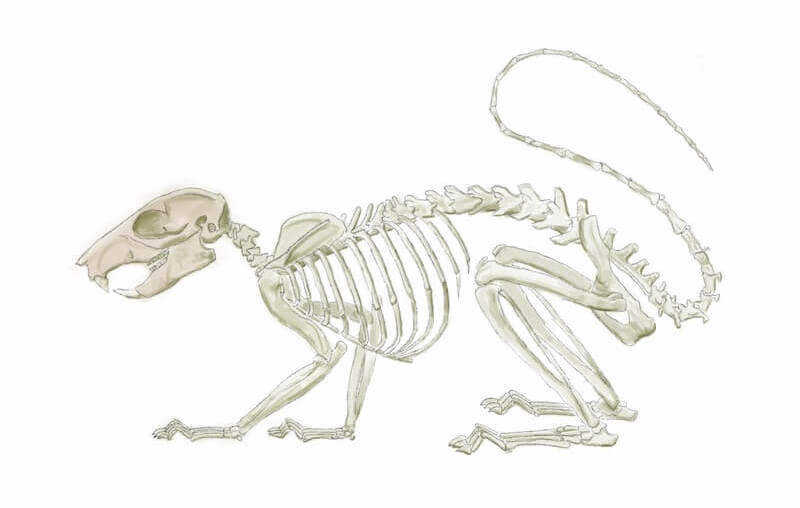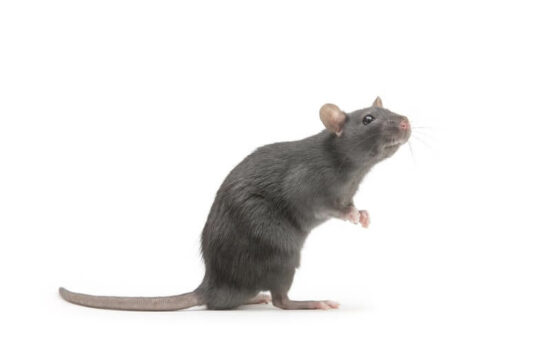“Do rats have bones?” is a common question we get from homeowners who are baffled by the agile and slippery nature of these pests. For such seemingly large rodents, they can go pretty much wherever they want?
This guide will teach you about the bone structure of rats, and what gives them their ability to sneak through small openings in your house.
Table of Contents
Do Rats Have Bones?
Rats have a long history of invading human spaces. They’ve been the bane of homeowners for eons, causing structural damage and spreading disease. The rodents are some of the most feared and hated pests around, and many people go to great lengths to keep them out.
Yet, they always manage to find a way in!
The rat’s tenacity and determination have led to tons of speculation and misconceptions. These animals have an uncanny ability to squeeze through the tightest holes and voids. As a result, many people believe they don’t actually have bones!
But let’s be clear, rats do have bones.
Expert Tip: These rodents actually have a complete skeletal system much like yours. If you were to look at a rat through an X-ray, you could probably point out many of the bones yourself. You’ll see the rib cage, the spine, the leg bones, and all the tiny digits on their feet.
Rat bones are tiny and thin, but they exist nonetheless.
The belief that rats don’t have any bones is simply a myth. While the origins are a bit hazy, the rumors likely started when rats became a problem for early civilizations. The rodents have wreaked havoc in most cultures, ruining crops and invading homes.
Of course, rats also famously caused widespread disease thanks to the fleas and parasites they carried! Needless to say, the rodents developed a strong reputation that persists today. Our ancestors didn’t know much about the biology of rats, but they certainly knew they were a nuisance.
The rumors of boneless creatures likely came from their ability to squeeze through tiny holes despite a homeowner’s best efforts to keep them out. They’ve even found their way through plumbing and vents, making their unique abilities seem even more unnatural.
What Is Their Bone Structure Like?
Believe it or not, a rat’s bone structure is similar to yours. The rodent’s bones are far tinier and more brittle, but putting a human skeleton next to a rat’s makes it easy to spot the similarities.
Rats are vertebrate animals. That means they have backbones and a skeletal structure with a spinal cord.
The spinal cord is the most visible part of the animal’s skeleton. It runs along the entire length of the body from the head to the tail.
Like humans, rats also have cartilage that connects the bones. The cartilage creates joints for mobility and flexibility. Rats have a few more bones than humans. They’re also more agile and have a unique body shape, resulting in their unique ability to squeeze into tight spots.

The skeletal system is relatively compact. It’s also complex, consisting of many individual bones. But all that said, it’s not as alien as some people think it is.
Contrary to popular belief, rats don’t have a distinctly different skeletal system. That’s not why they can get around as easily as they do. Rats can squeeze into holes and maneuver tiny voids because of their body shape and flexibility.
Rats have a naturally cylindrical body. You don’t usually notice the shape because rats will compact their body when eating or resting. But if you watch one stretching, you’ll see that the body is far longer than the rat lets on.
They’re like soft sausages. When they need to get out of a sticky situation, they’ll stretch out, allowing their fat and organs to compact against the skeletal system. Interestingly, rats can also move their arms and legs to reduce their overall shape.
Do Their Bones Flex And Move?
Rats do not have bones that flex, fold, or bend. Their rumored bending skeleton is nothing but a myth that stems from the rodent’s ability to get through tight spots.
Ever wonder just how thin a rat can get as they push their bodies through a hole? Typically, rats can fit through a void no bigger than a quarter. That’s less than an inch in diameter!
Of course, how tiny the rodent can get depends entirely on its size. Smaller can squeeze their bodies even smaller, making them an elusive nuisance in homes.
Despite the rumors and myths, rats don’t have collapsible skeletons. Their bones are dense and rigid. They can only take so much pressure before breaking. Rats can experience broken bones just like any animal.
Their ability to roam your home undetected isn’t because of folding or bending bones. If it were, these pests would be a lot harder to catch. If they had flexing bones, they’d get out of traps without any issues (thankfully that’s not the case).
The only form of bone flexing rats experience is in the joints. Like humans, rats have cartilage on the joints that cushion the bones and allow full mobility.
As mentioned earlier, these creatures simply stretch their bodies and use their natural flexibility to make their form as compact as possible.
How Many Bones Do They Have?
Rats have a total of 223 bones. For comparison, humans have 206. Those 17 extra bones could play a part in the rodent’s flexibility.
These creatures have several shorter bones connected through joints and cartilage. They have extra vertebrae that allow them to experience more mobility than humans. Take a look at the thoracic vertebrae.
Humans have a total of 12 thoracic vertebrae. However, rats and mice can have up to 14. It might not seem like a huge deal having a couple of extra, but it shows that extraneous joints and cartilage make rodents far more capable of moving around challenging environments.
Expert Tip: That’s just one example of unique skeletal anatomy. Rats have other joints in other areas that are non-existent in humans. While these pests don’t have bending, flexing, or collapsible ones, those additional bones and joints provide the agility rats need to survive.
Conclusion
Now that you know rats have bones and understand how their build allows them to move through your house, it should be a little bit easier to keep them out. Small openings that you thought weren’t an issue might need to be patched, and the areas where you place traps will likely change as well.
Knowledge is power when it comes to pest control!


